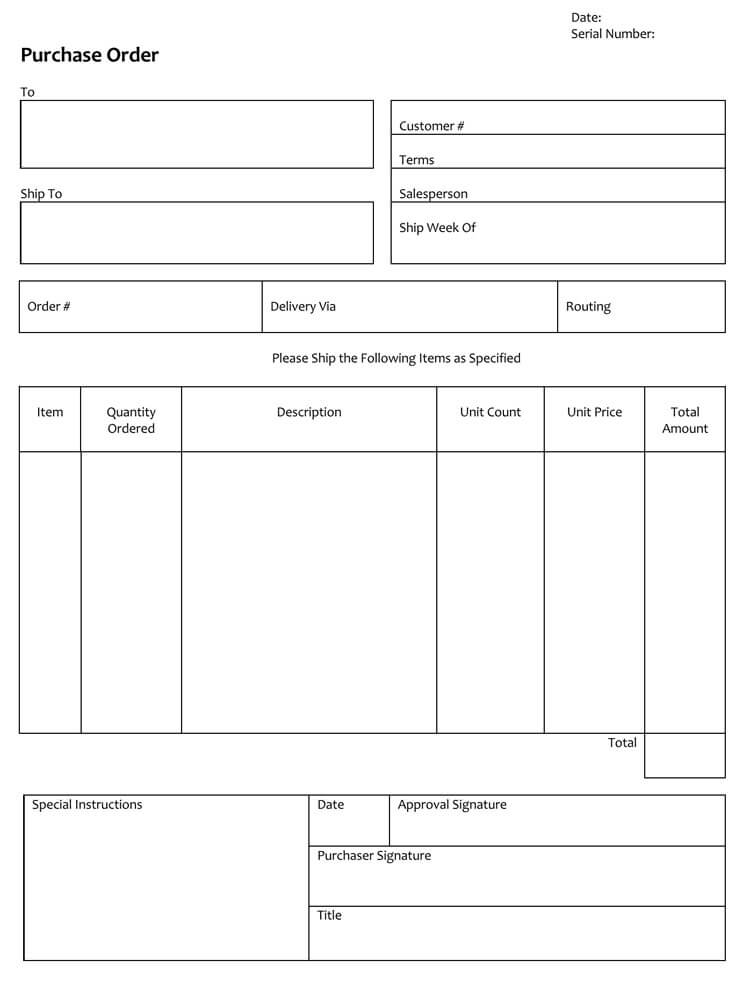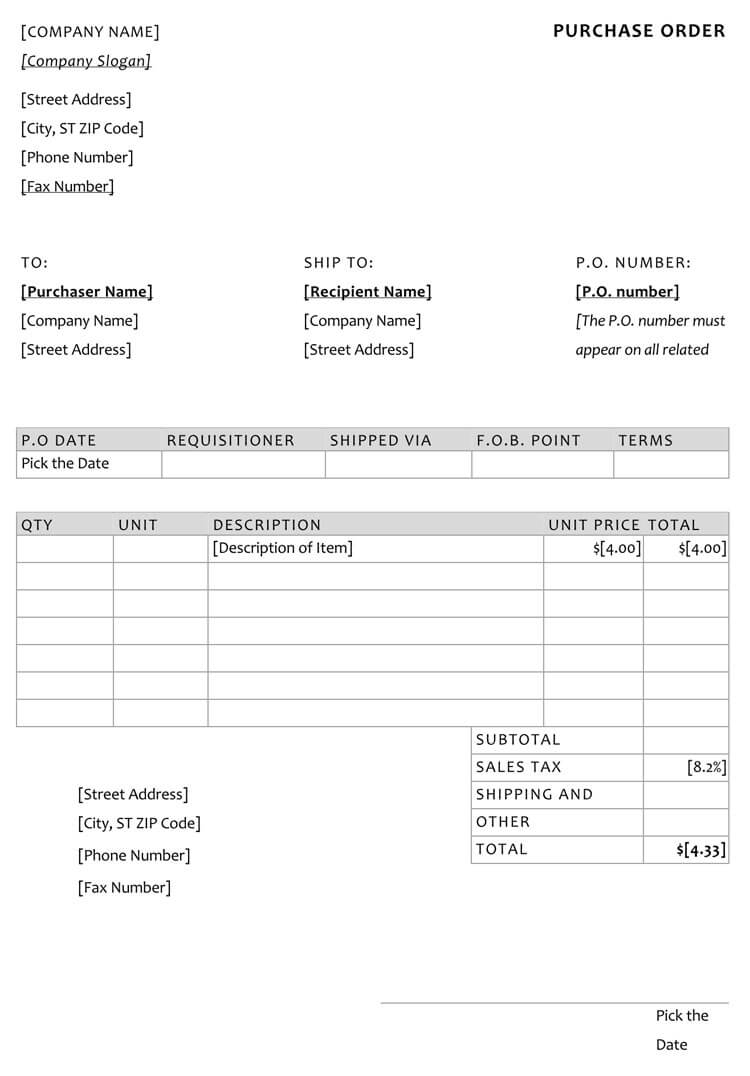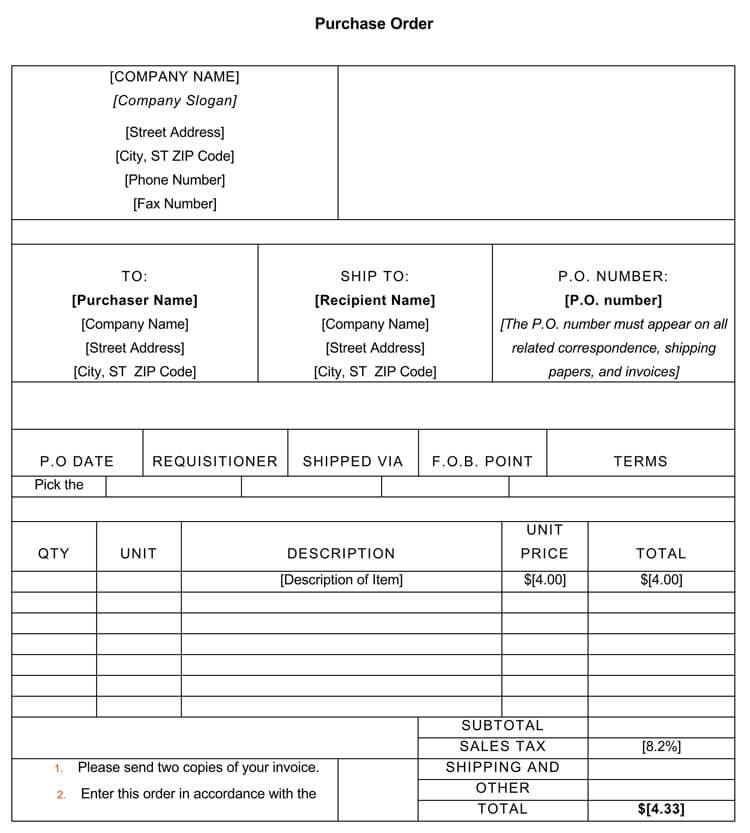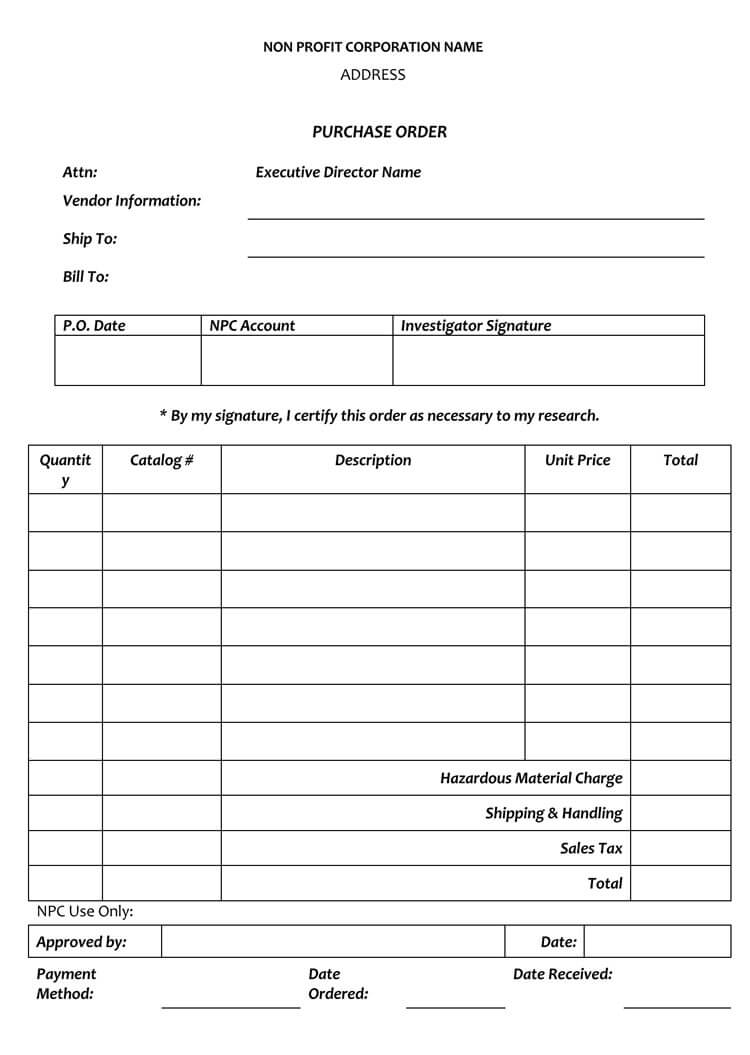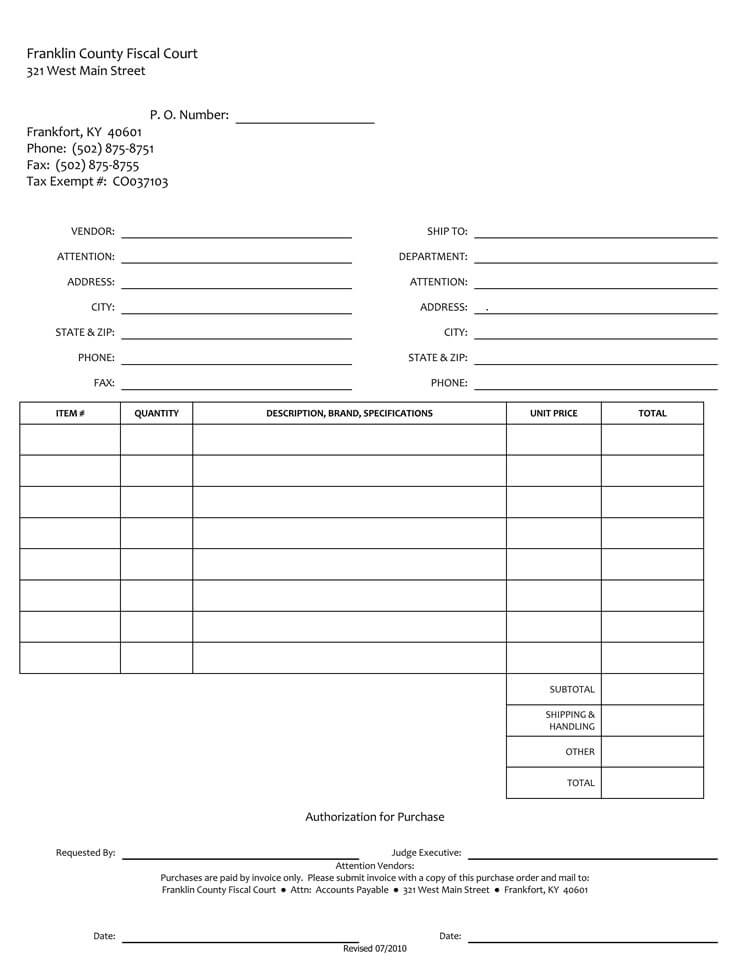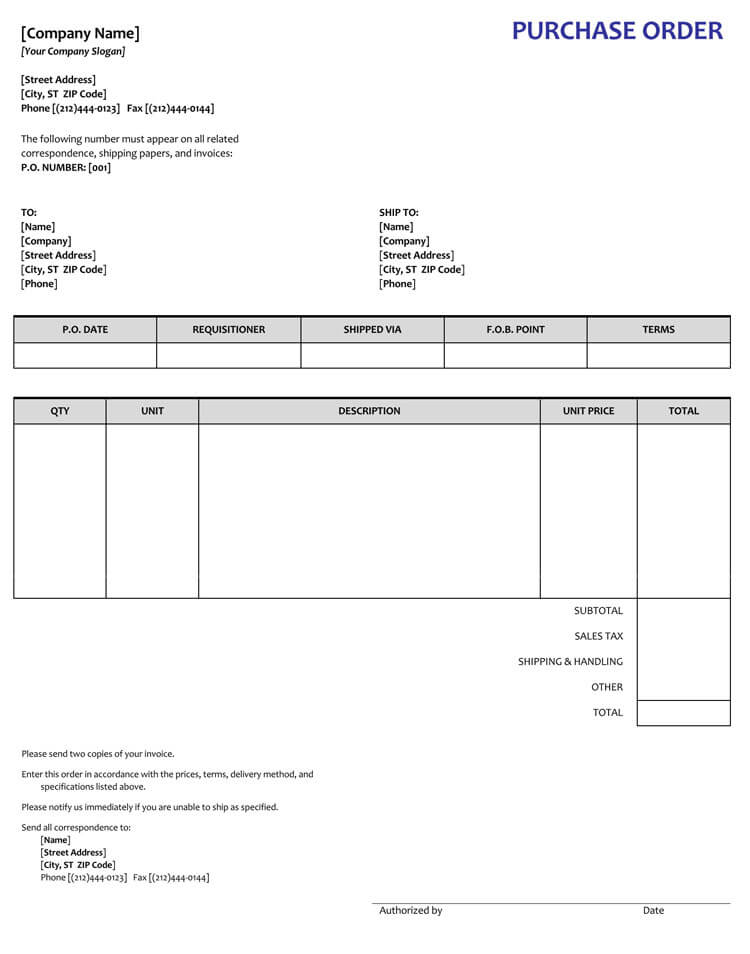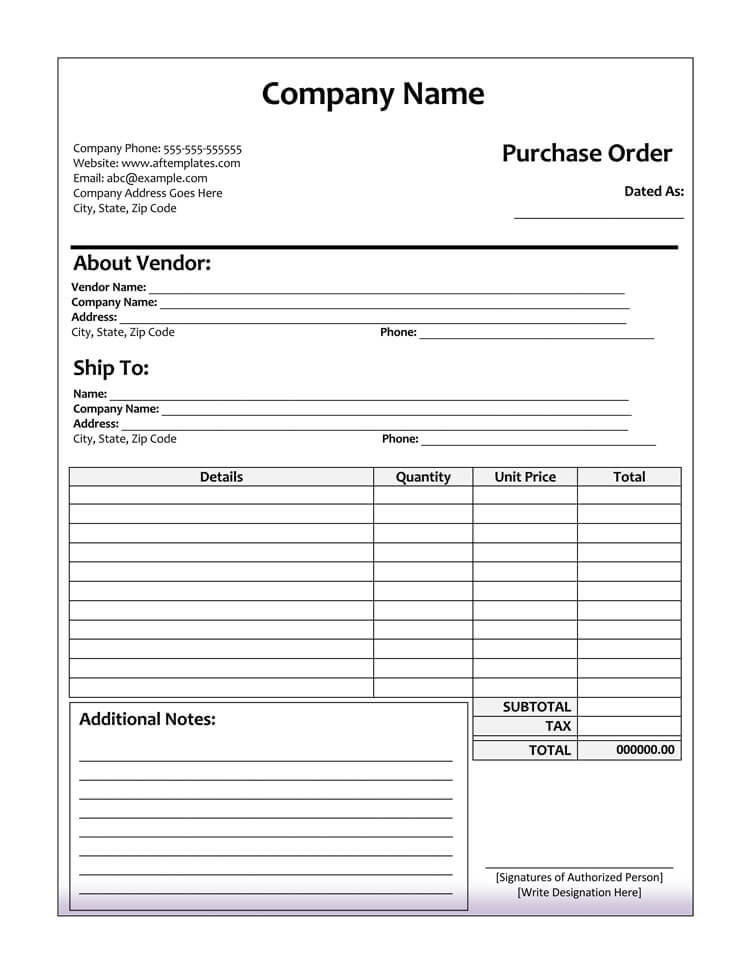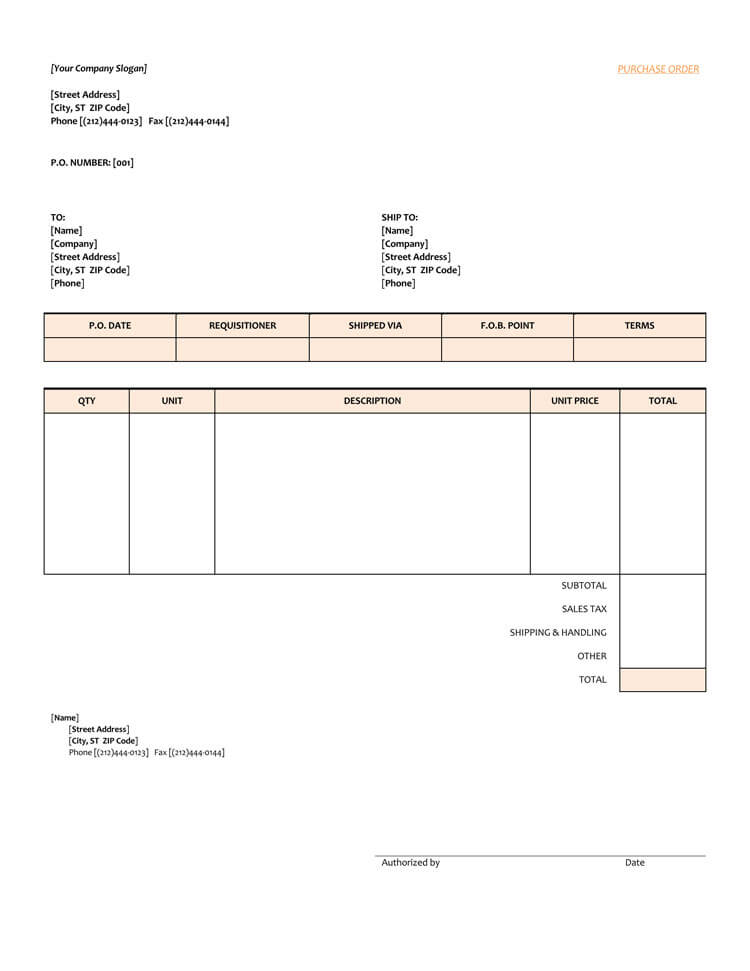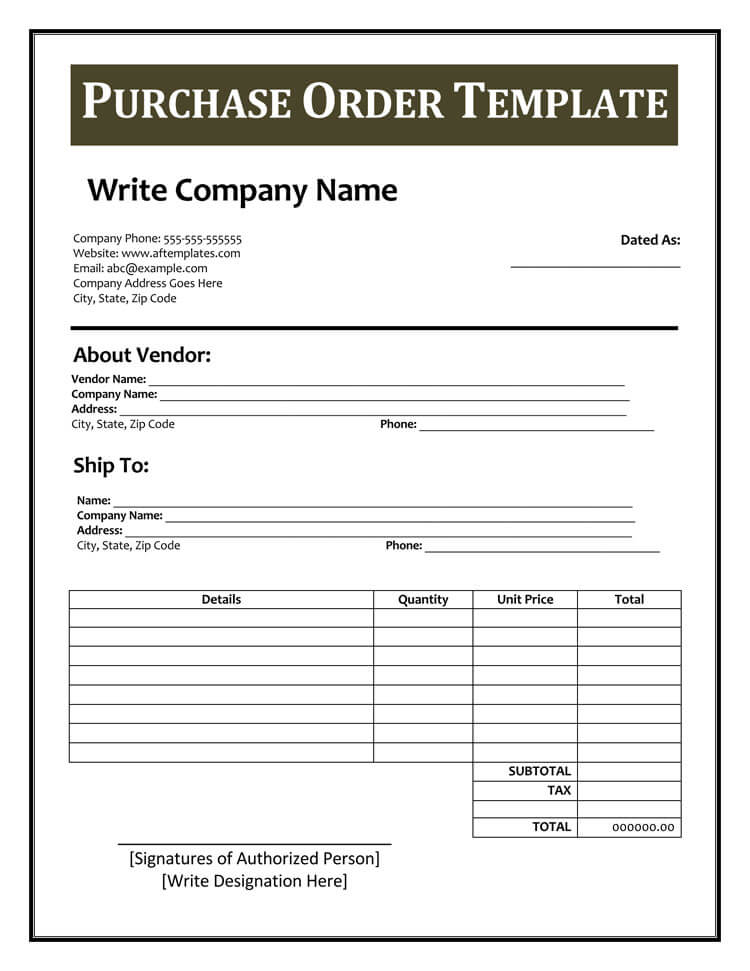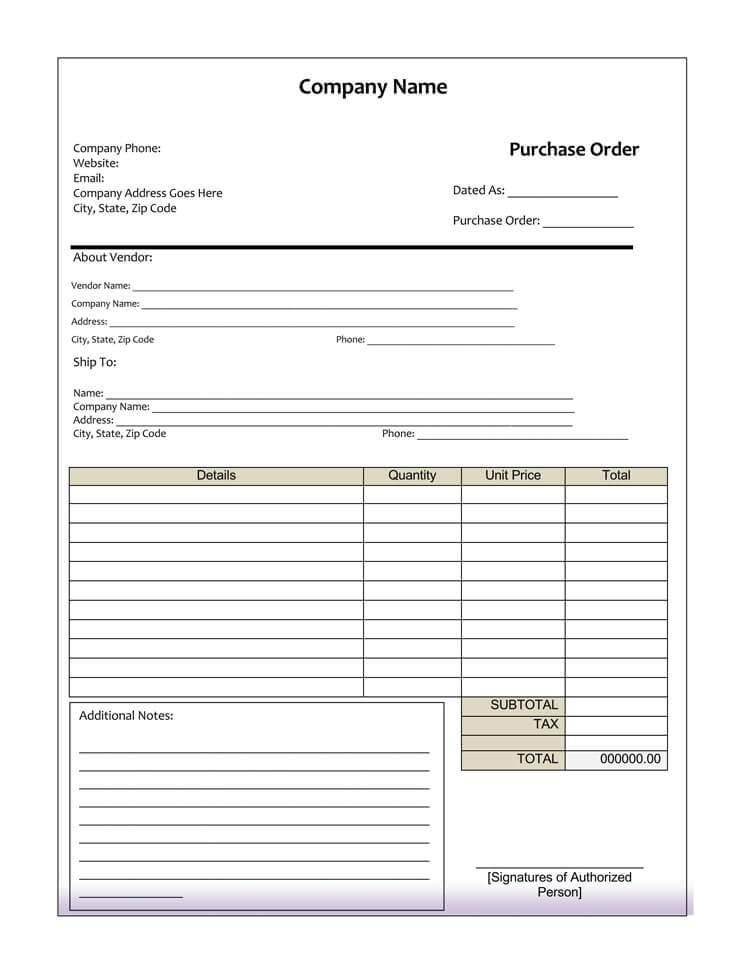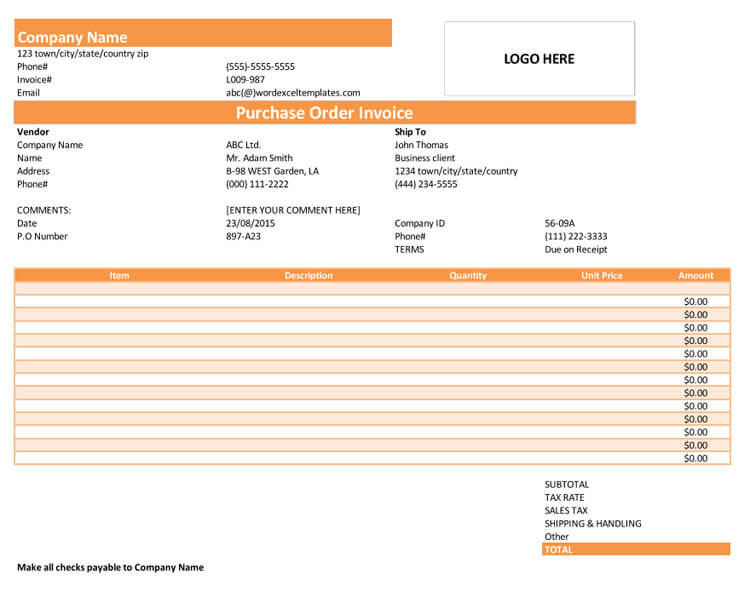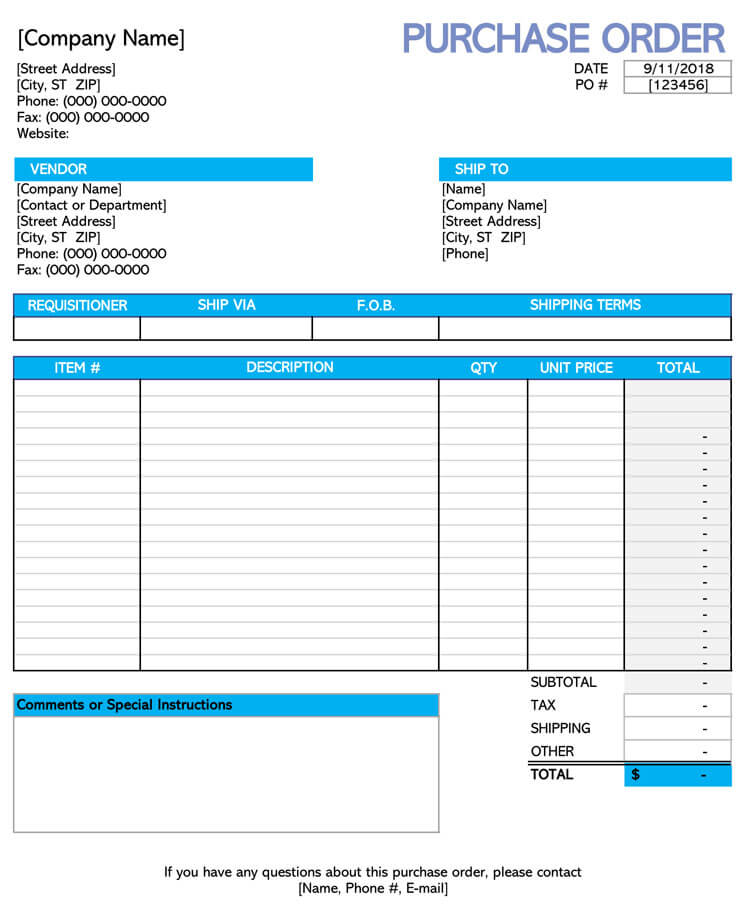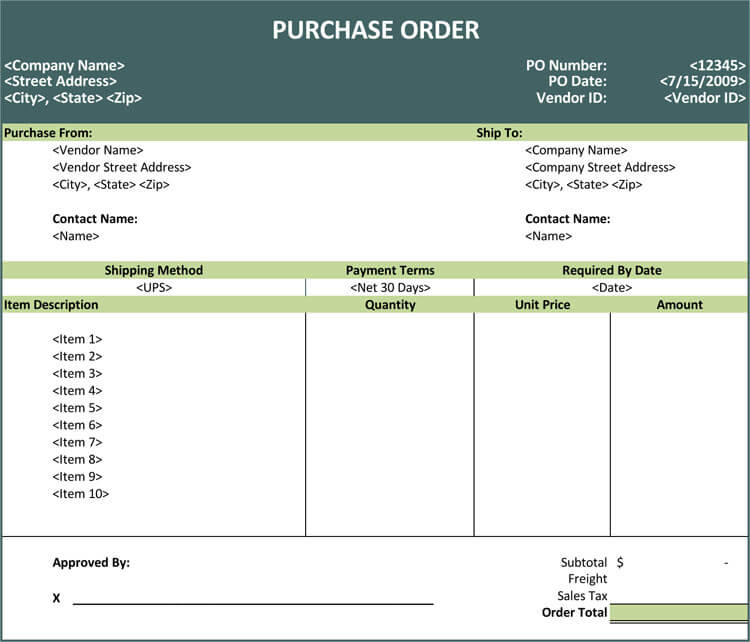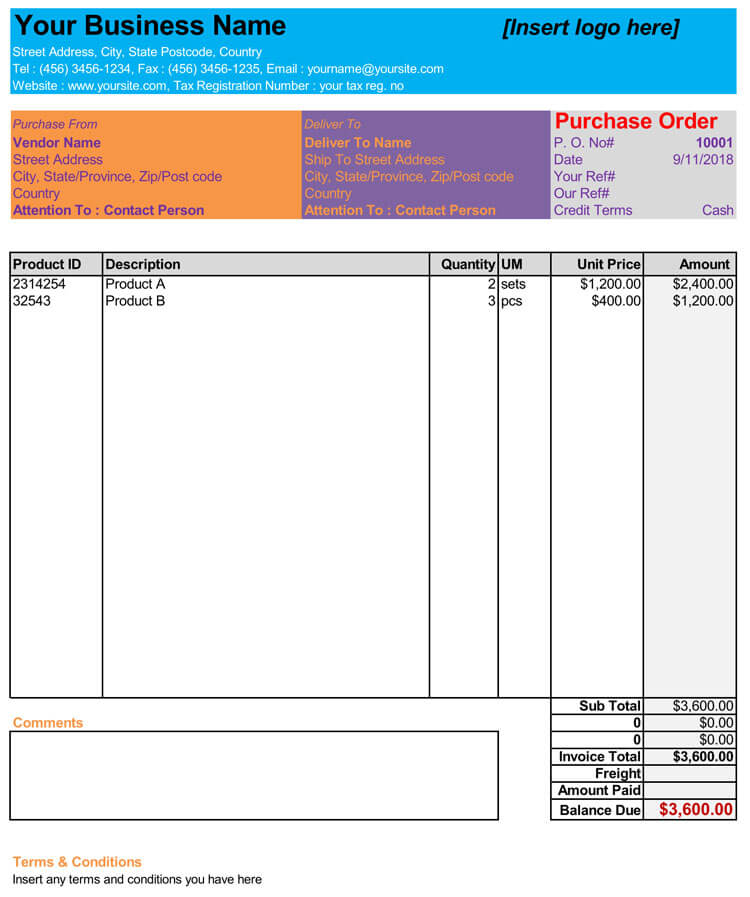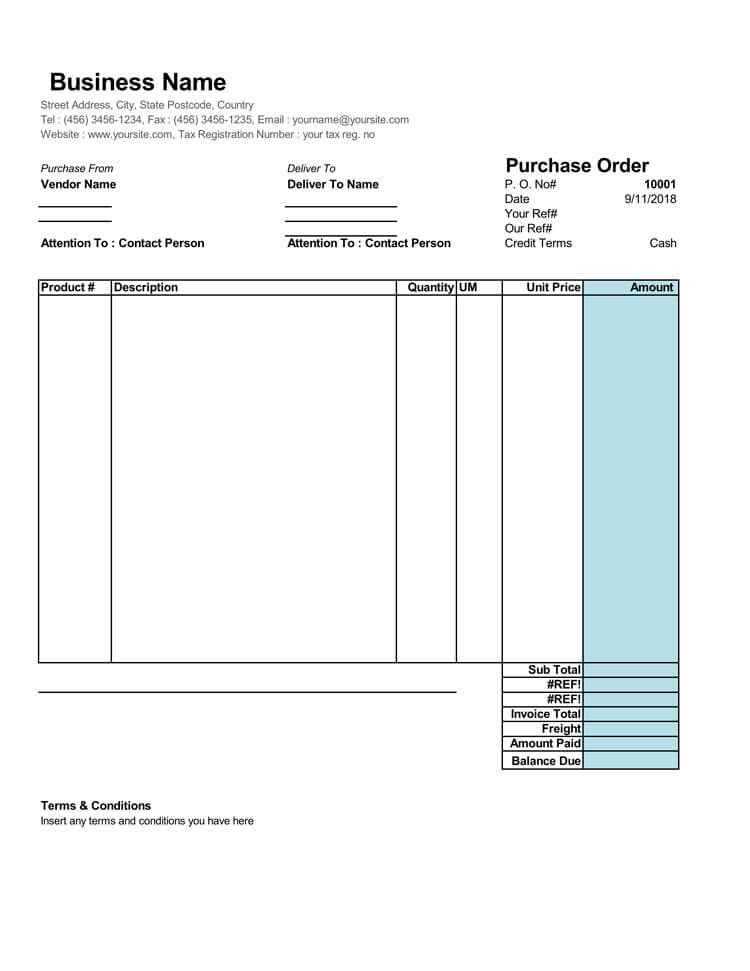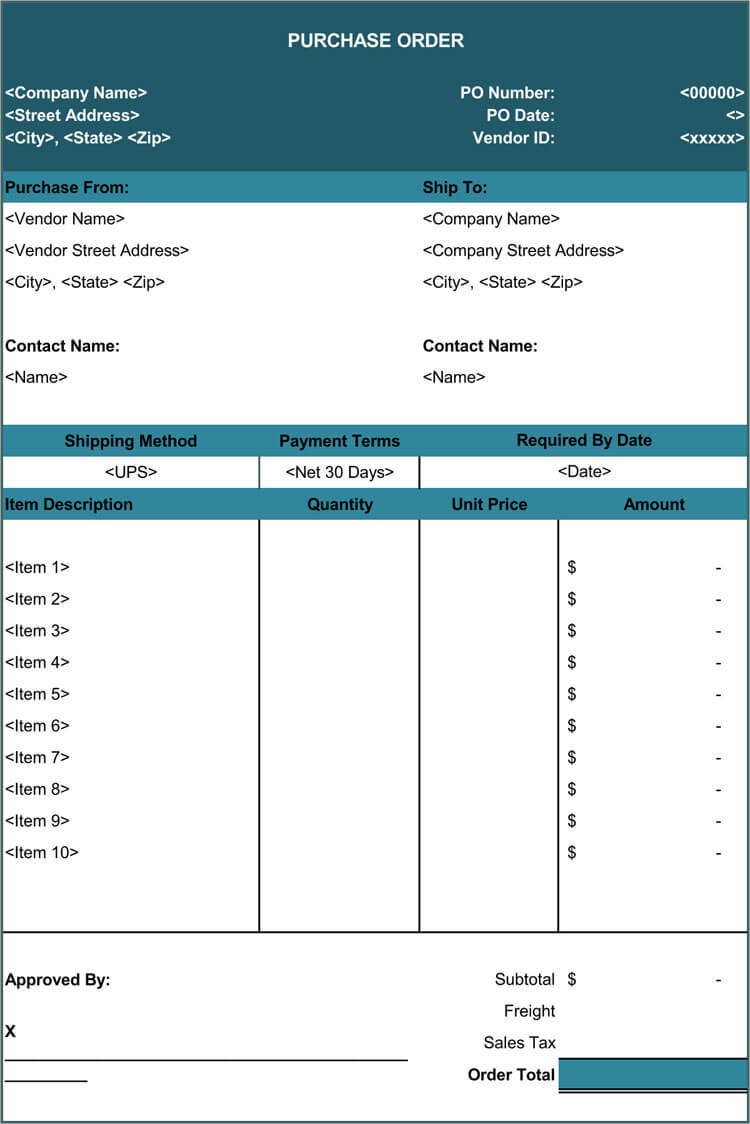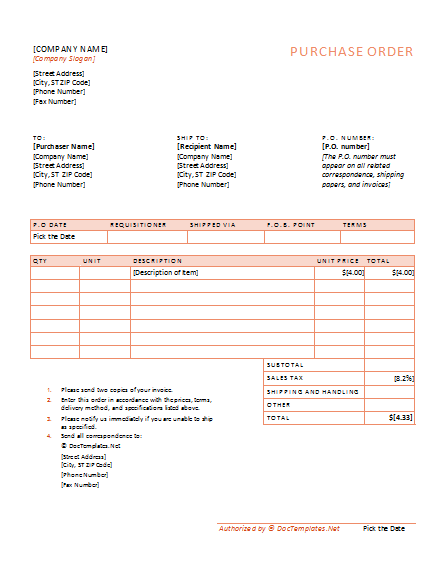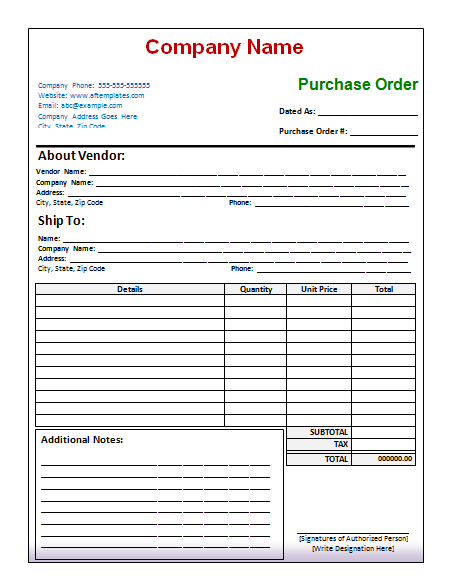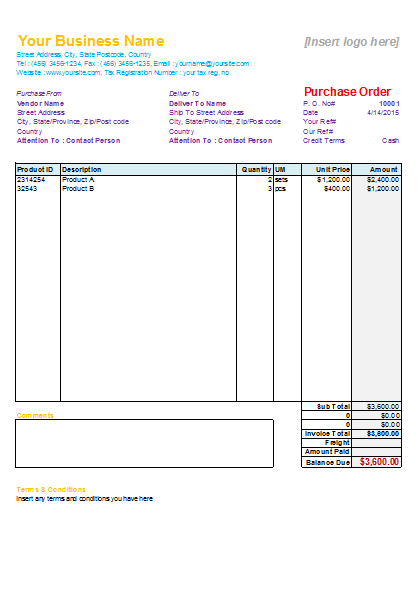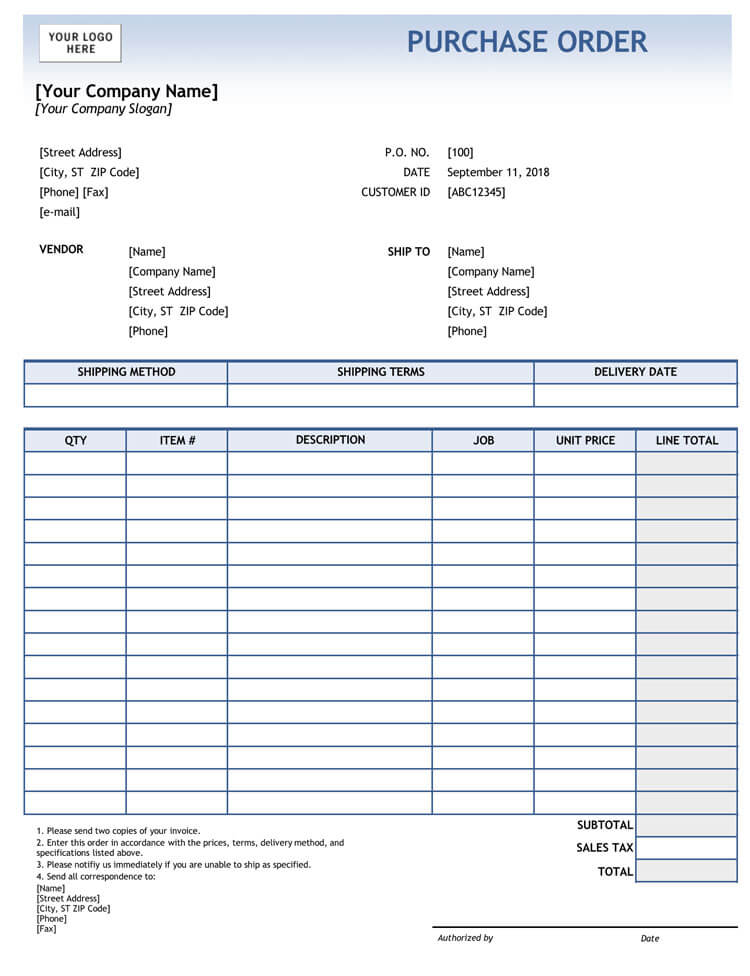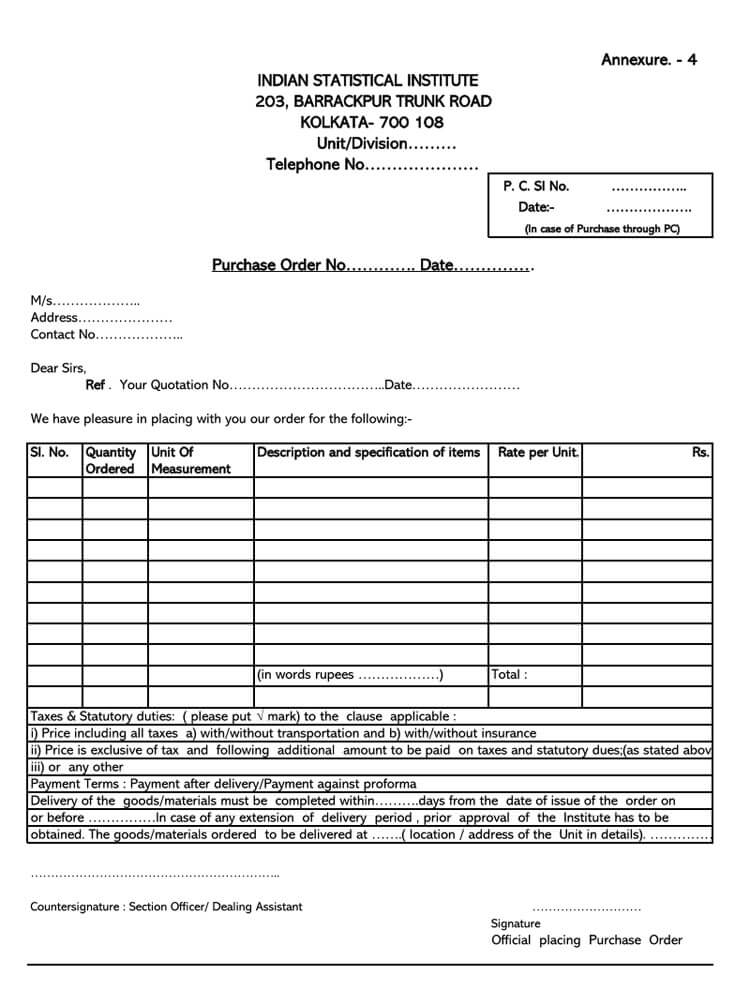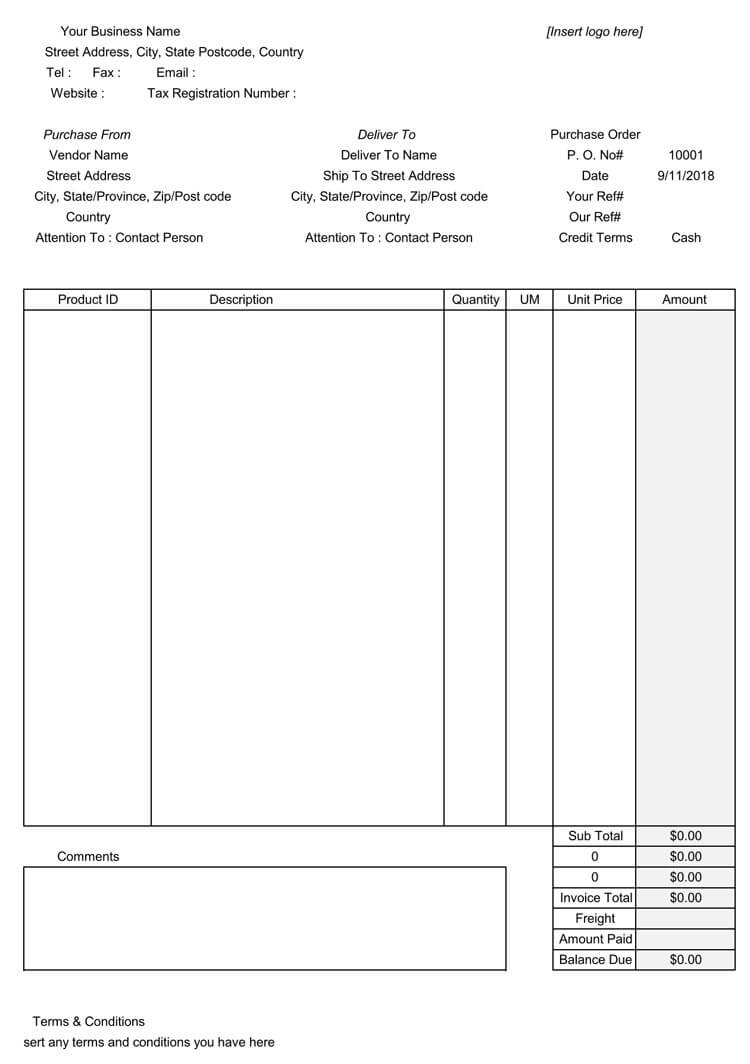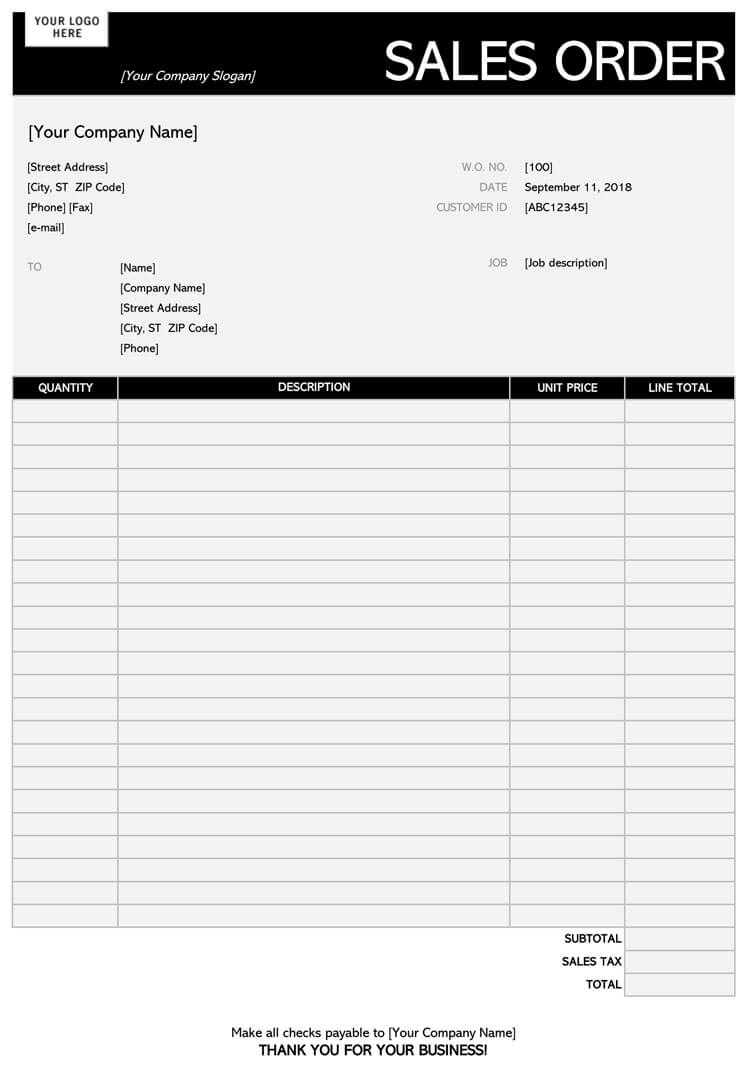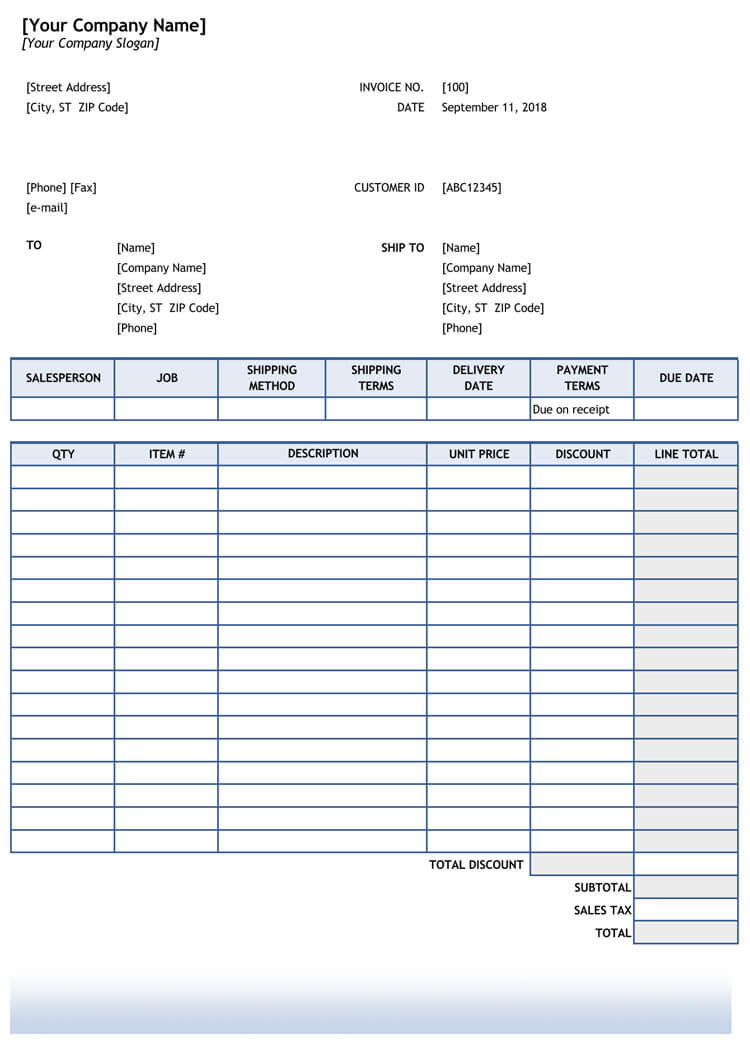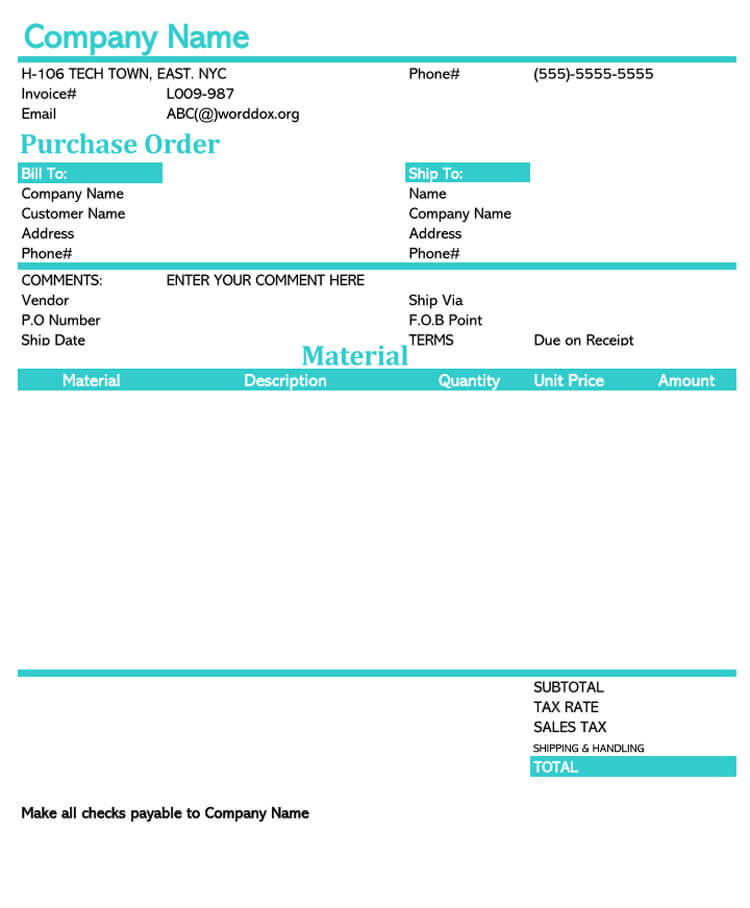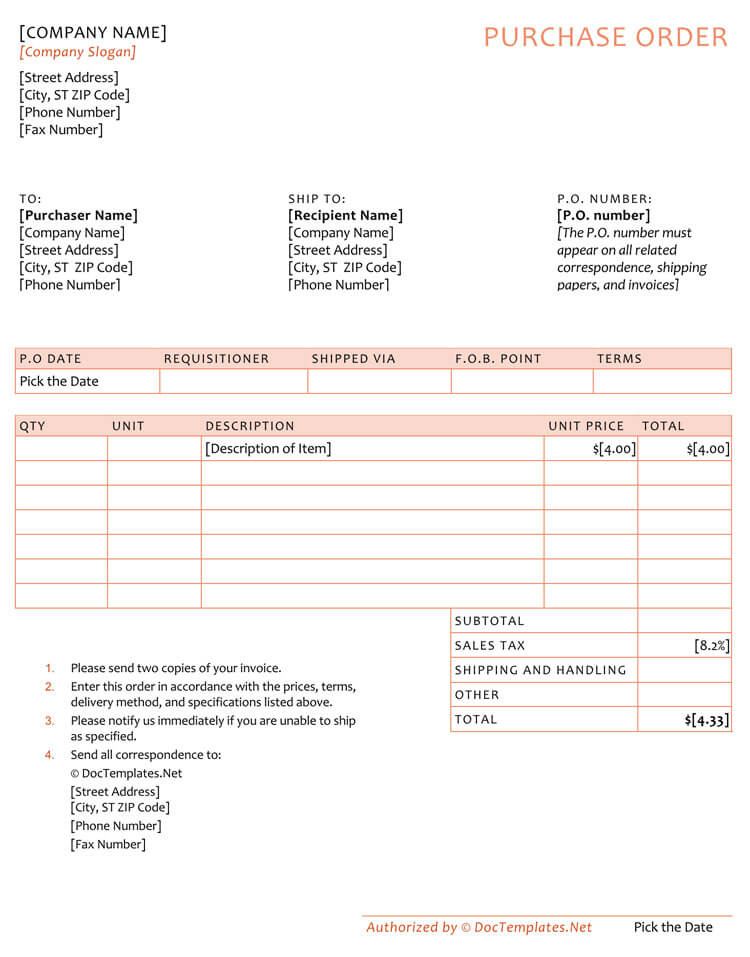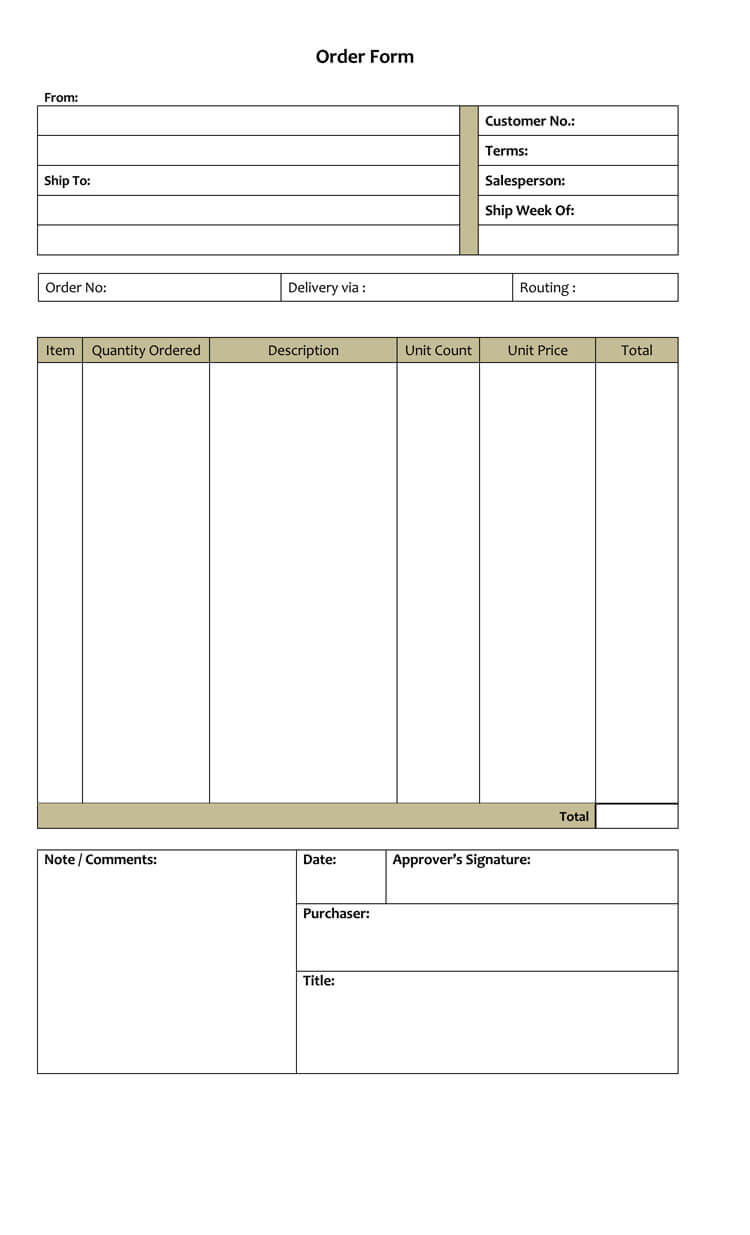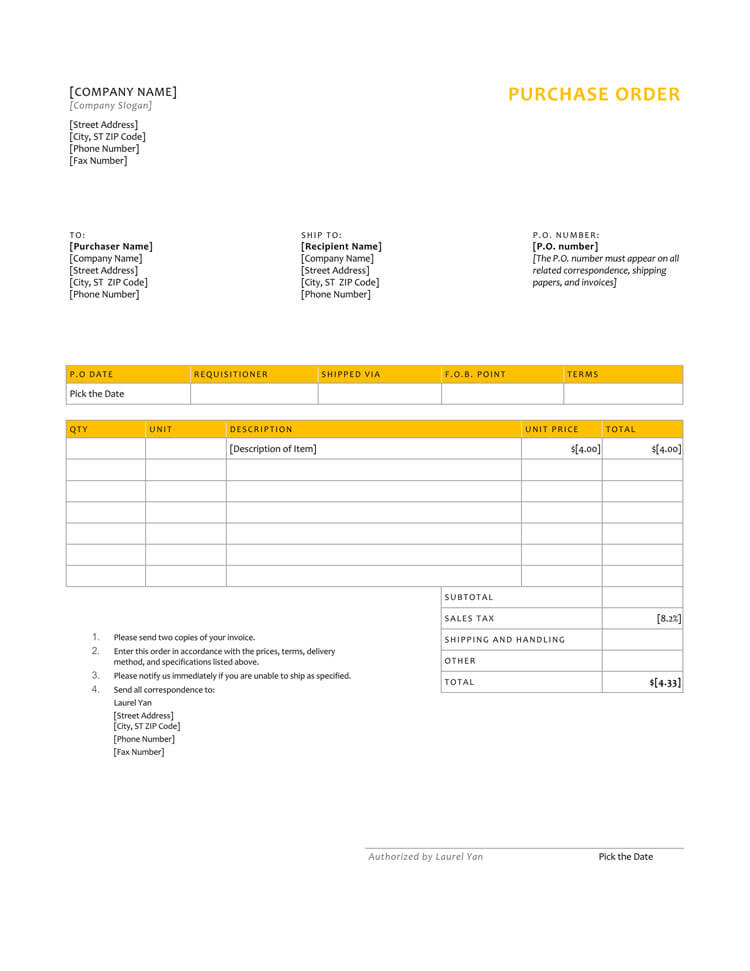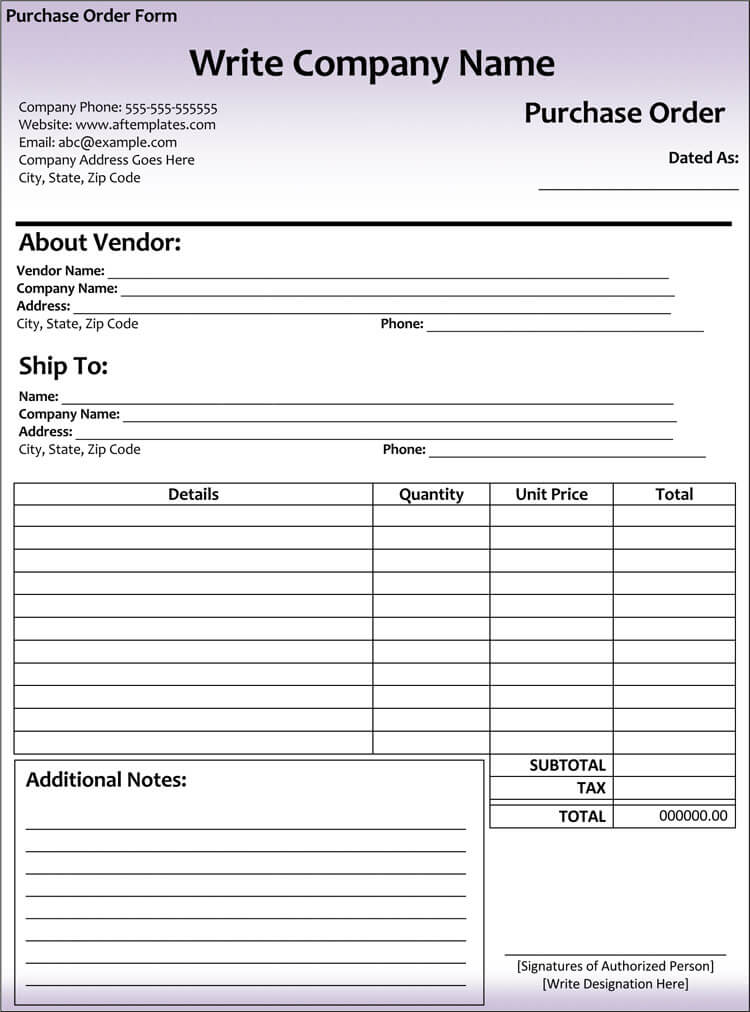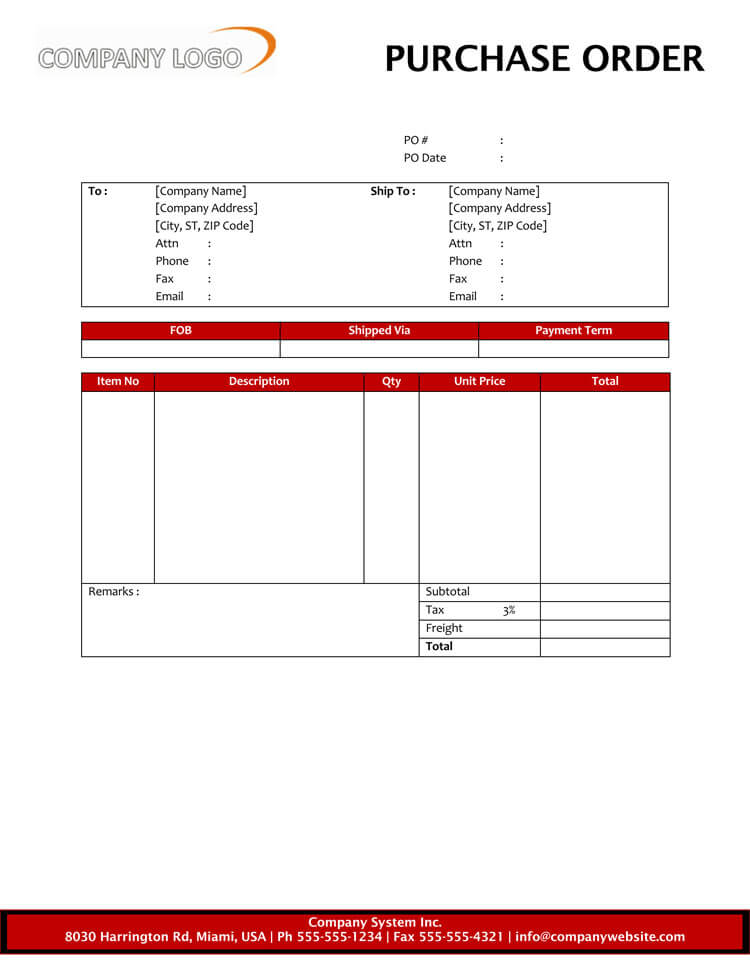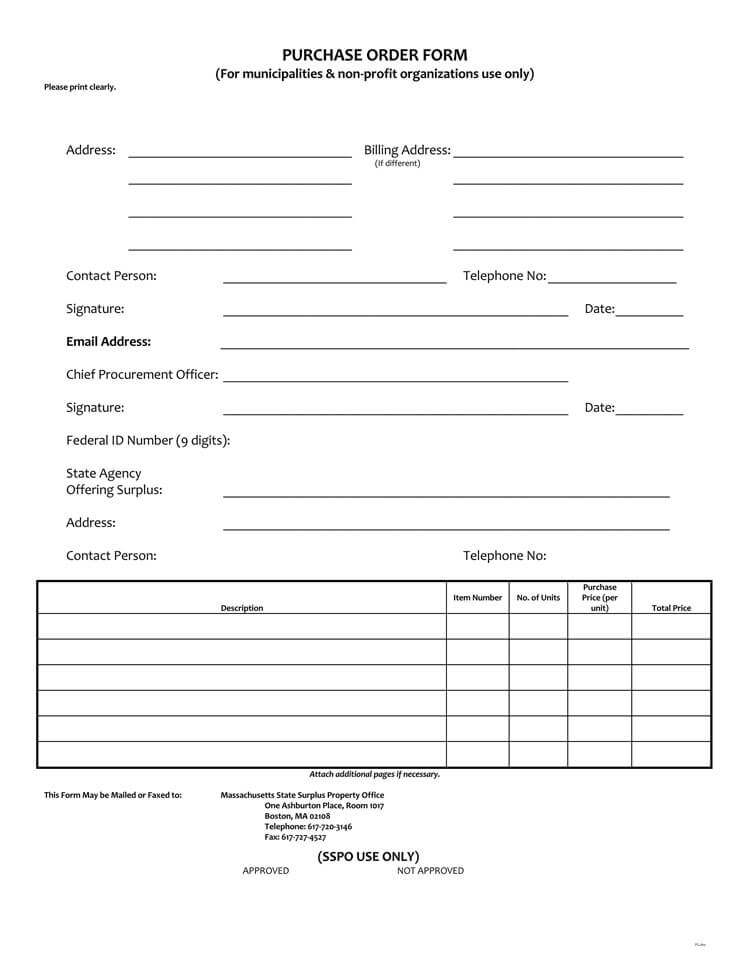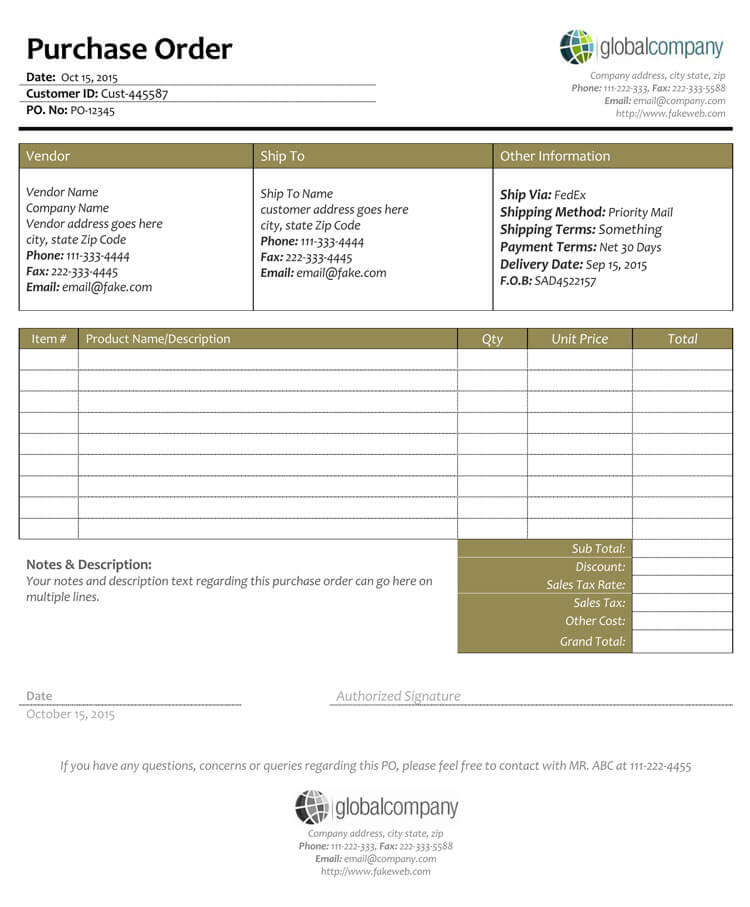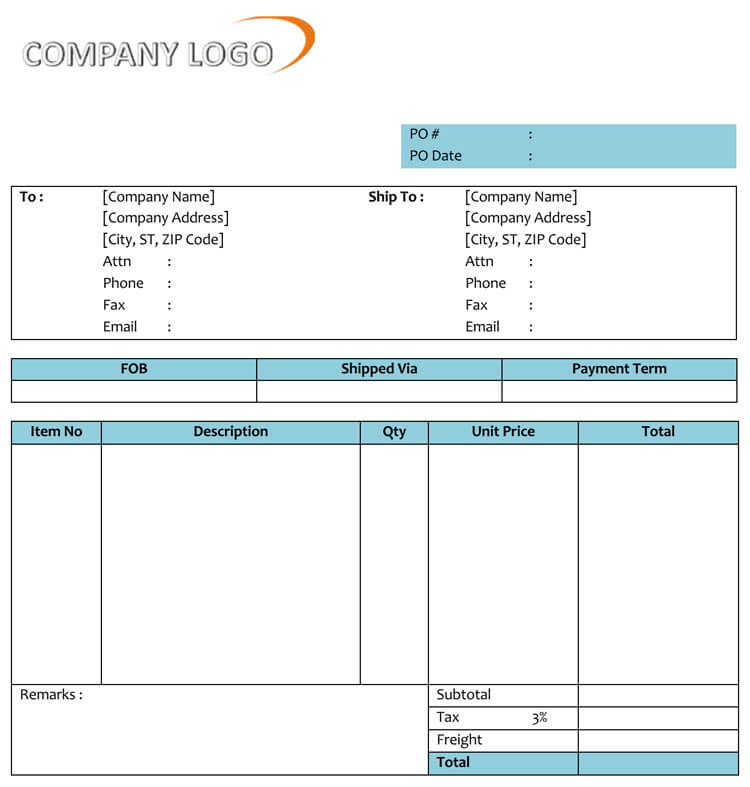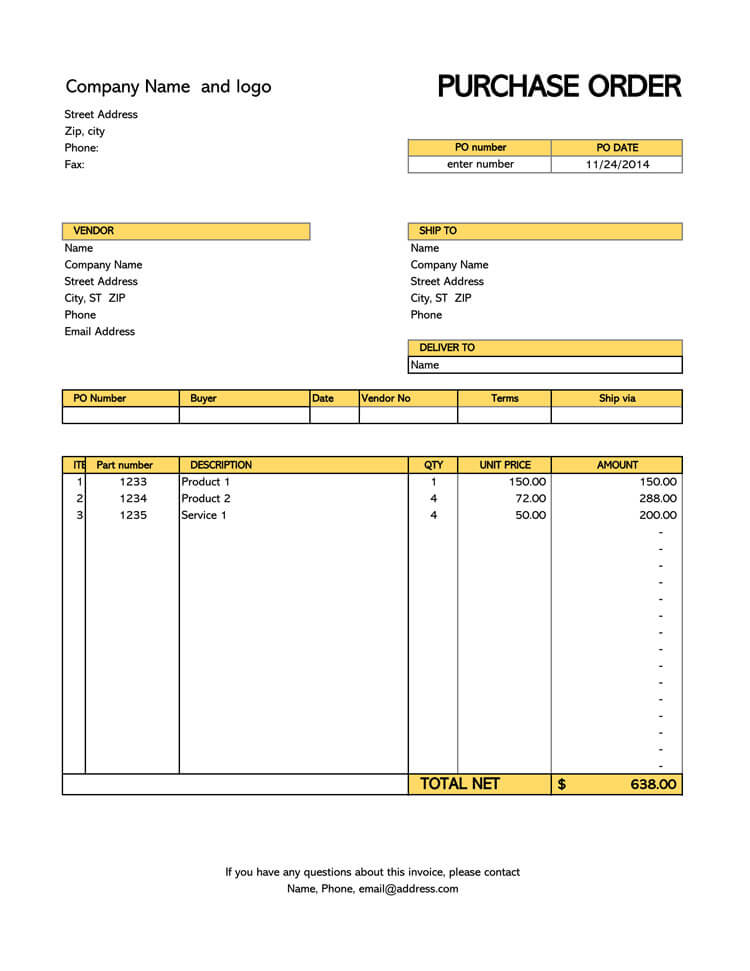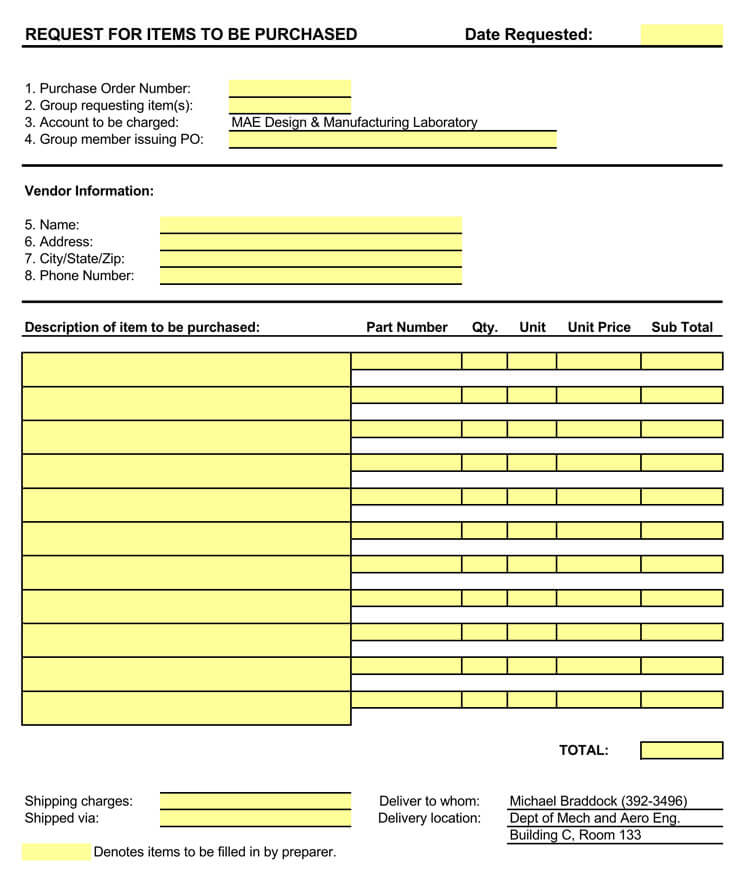A purchase order is an agreement between the buyer and the seller regarding the products for which the buyer has placed an order.
A purchase order is also referred to as “PO” and is also known as the work order. It serves in developing a formal contract between two businesses working in the marketplace.
If you are a buyer and need to fill the purchase order for the first time then you should use the purchase order template to avoid entering any incorrect information and also not missing out on any crucial part. The purchase order template will help you while buying any kind of product from anywhere. It is a better option to seek help from the template while filling the purchase order because it is a formal document and requires to be filled carefully and accurately.
Your order will be confirmed only when you have filled the purchase order template completely and once it gets confirmed, then the purchase order acts as an agreement between you and the seller. So the purchase order template will be very helpful for you because it will assist you in making fulfilling all the terms and conditions required to make the agreement.
The purchase order template can be freely downloaded from our website according to the type of order you want to place for the product you want to have. Once the template is downloaded, it can be easily edited for writing all the information according to your requirements.
Purchase Order Templates (Word)
When is it used
A purchase order template is commonly used all over the world in almost all types of businesses and you will also have to fill it while placing an order for anything. So the purchase order template will make it easy for you to fulfill all the requirements as per standards and it is filled soon after the order has been placed.
Purchase order templates can help you for various purposes while buying any good or service from any business and also to get the services by following all the terms and conditions appropriately. You will decide the cost of products before your order gets confirmed. The template used for the purchase order will be great as it will indicate that your order is authentic and you really want to order a particular product from any company or brand. It will also lead to keeping the records accurate.
Large businesses require a purchase order template because whenever they order something it is always in bulk amount from any other company and they can keep authentic proof of everything they have ordered. It is commonly used in the following areas of the marketplace:
- Construction firms
- Ad agencies
- Retailers
- Other vendors etc.
A purchase order helps you in developing a trustworthy position of your company in the market as a buyer because it ensures that the payment will be made at the specified time. When the purchase order gets accepted then it becomes a legal document between you and the seller so the purchase order template will help you in better understanding all the legal terms as well and your business will continue to grow.
Purchase order template can be used by your company in case you do not have enough budget at a particular time for buying the products but you expect that you can pay later on so you will use the purchase order as a surety that you will pay the amount. So a purchase order can be used for making your document
- Legible
- Properly formatted
- Authorized
Despite the large network of your business setup, the purchase order template will help you in following all the standards for placing different orders from various companies.
Types of Purchase Order
The purchase order templates choice depends mainly on the buyer’s preference, availability of goods or services. Although the types of purchase order templates differ in the information present, the buyer can obtain satisfactory service from any of them.
Contract purchase order
This is the most formal purchase order type. A contract purchase order requires both buyer and seller to sign an agreement before issuing the purchase order, referencing the legal arrangement. This form of purchase order comes in handy when the buyer does not have a definite delivery date in mind; both parties will agree on the terms and conditions of the transaction but will make decisions on the quantity and items in the future.
A contract purchase order is typically a binding contract that says a buyer will purchase goods from the seller in the future. Usually, both parties agree a year advance, and during this period, the buyer can make specifications for the order, including essential details for each item.
For example, if a small business orders for the supplies of computers, it must sign a contract that defines the items, quantity, prices, and date of collection. This contract will precede the issuance of a standard purchase order. Thus, both the seller and buyer of the items will be under a legal contract, making the business deal productive and easy.
Standard purchase order
This purchase order type is the most common and is the usual purchase option for one-time purchases.
Here, the buyer gives details of the items they want to purchase, the number of items, pricing, and the exact delivery date. A standard purchase order also includes the payment system, which gives the seller clarity and ensures no miscommunication between the seller and the buyer.
You can make a standard purchase order template for various functions depending on your preferences and needs. For example, a stock purchase order will be suitable for consignment, services, or subcontracting. On the other hand, a gift store might make a standard purchase order template for a new set of wooden racks or show glasses. If everything goes well and the seller supplies the exact item specification, the purchase order’s closure and the transaction is complete.
Blanket purchase order
A blanket purchase order allows the buyer to order multiple items at once to negotiate a discount. This is most efficient in retail business and increases the profit gained on goods and services. This type of purchase order allows the buyer to outline the number of items and item specifications needed and may or may not include the prices of the items on the list.
If the buyer indicates the price, they may also include the discounts that the seller offers. For example, the buyer may decide to buy 100 packs of gift bags but may not be certain when they require the order’s delivery. In the event of this, the buyer issues to blanket order to begin the process of purchase.
Planned purchase order
A buyer places a planned purchase order to anticipate future needs and puts the demand for items before an actual need for such things. In this type of purchase order template, the buyer states details such as the pricing and quality of the items. However, the quantity may be an estimate, and the buyer would likely set an estimated delivery date.
For example:
If the buyer is running low on gift bags but is not yet out, this purchase order allows the buyer to request the supply of gift bags at a flexible delivery date.
What is Included in Purchase Order Template?
While downloading the purchase order template you should check that the following things are present on it:
Name of buyer and seller / Company name: Full name of the buyer and that of the seller should be written in separate lines along with the full name of both the companies; from which the order is being placed and the other one which will provide the products.
Contact details of buyer and seller: Complete address of both the companies and contact numbers of both parties should be written while filling the purchase order template.
Name of product: If only one product has been ordered its name should be mentioned and if there are more than one number of products are required then the name of each products should be written separately along with number of units of each product required.
Product description: A short description of the product should be written below the name of the product because it will help in carefully handling the products according to their nature to avoid breakage or any other damage that could occur during the delivery.
Purchase order (PO) identification number: Each purchase order (PO) has a specific number which should be mentioned over the template for recognizing the order accurately.
Cost of products: The cost per unit of the products should be mentioned along with the total amount and then the subtotal will be made at the end by adding up the total amounts of all the units of each product.
Delivery charges: If delivery charges are not included in the product cost then it should be written on the purchase order template separately to avoid any confusion.
Payment terms: The time period after which the payment will be transacted and how will it be transferred should be mentioned in the section of payment terms.
Purchase order date: The date when the purchase order was approved by both parties should be clearly written on the template.
Delivery date: Most importantly, the delivery date on which the buyer will receive the goods should also be written by the mutual consent of both the companies.
Purchase Order Templates (Excel)
Purchase Order Format
There is no hard and fast rule for the layout of a purchase order.
However, the purchase order can take the following format:
Header: A header is required in the purchase order, as this allows for the provision of general company information, which includes the company name and address, number of each item, and date of purchase order.
Information of the supplier: It describes the recipient of the purchase order and must clearly state the contact name and vendor or seller address.
Ship to: Covers shipping information which includes the shipping method, date of sound delivery, place of shipment, and terms of shipment.
Order details: This describes every item on the purchase order and provides the item name and description and a line code and quantity. It also includes the price of one of each item, the number of units requested, and the delivery date of each item on the purchase order.
Summary: Complete the purchase order form by stating the subtotal and discounts, shipping costs, taxes incurred, and the total items purchased.
Purchase Order Process (How it Works)
The purchase order process flow starts when the order placed by you gets approved. For this purpose, you will have to use the purchase order after completely writing the details in the template and send it to the company from where you want to buy the products. The approval will be granted by the seller once they have all the materials required for manufacturing the products you have ordered. The seller company will send back the purchase order template to the customer after approving it which is then accepted by the buyer after reading the terms and conditions mentioned by the seller carefully.
When the purchase order is accepted by both the parties and gets approved by both of them, then the purchase order becomes a legal agreement between them in which all the following essential information is mentioned:
- Ordered products.
- Price of products agreed between the buyer and seller.
- Delivery date.
- Terms of payment.
All of this process is completed in the form of an interconnected cycle that’s why it is named as purchase order process flow and is followed by all the well-reputed business setups. This process and all the steps may vary for different businesses and it may vary for varying types of products so appropriate changes may be made by the businesses themselves.
The whole purchase order process flow has been given step-wise in the following points for a better understanding of this process:
Choice of items to purchase
You as the buyer identify a need that the seller’s product can fulfill before placing an order. The buyer needs to determine the number of goods they need and propose a date for delivery when possible.
For example:
If you need to order new gift bags to package your customer goods, first calculate the number of packs you will require and then pre-order in anticipation that you will need a delivery of these items. You must be sure to determine the exact quantity of goods that you will need to avoid cost multiplicity.
You can create purchase orders afresh, especially in the case of recurring or piggybank purchases, but also, as in most cases, you can create a purchase order template from purchase requisitions that have undergone approval. Here, the stakeholders are the administrative staff and the procurement team. The stakeholders involved in the choice of items to purchase consist of the administrative staff, requisitioner, sign-off authority, and procurement team. They will need to approve all purchase orders and process the payment.
Choose a vendor
The vendor should be the best source of the items on the purchase order and should be able to fulfill all the terms that you have listed on your purchase order.
Create a requisition
The first step in the purchase order process flow is to create a requisition for your purchase order in which all the basic and initial details regarding the order placed by your company are mentioned so that it can be reviewed by the other departments working within your company.
Approval of requisition
The requisition undergoes a review from all the concerned departments regarding different sections of the product details. After analyzing all the information and keeping them in accordance with the company’s resources after making the required changes, the requisition gets approved. Both of these steps are completed before the creation of the purchase order (PO).
Notification to vendor
When the buyer company approves the requisition, a purchase order is made. It is then sent to the vendor of the seller company by notifying him and requesting to review the purchase order to see if they also agree upon all the terms and conditions.
Acceptance of order
When the purchase order is sent to the supplier company, it is up to that company whether they accept the order or not. If the selling business setup rejects the purchase order then they should tell the reason for doing so. On the other hand, if the supplier accepts the order then both the buyer and the seller may make negotiations for adding or deleting any terms of conditions and then finalize the purchase order after which both the parties will be obligated to follow the instructions as mentioned in the document.
The binding contract
In a mutual agreement between both parties, a binding contract governs their transactions. This must include the buyer’s details, information of the seller, purchase order number, details on goods ordered, and terms of payment, price, and information on payment specifications and delivery method.
Service fulfillment
After the approval of the purchase order, it is the seller’s responsibility to supply the items stated in the purchase order. The seller can also generate an invoice that indicates the total cost of the items in the purchase order. This invoice summarizes the number of goods supplied and the cost owed to the seller.
After the approval for the purchase of the gift bags, you are to receive an invoice stating the cost of the items and a fulfilled order. Per the terms of payment, the seller might expect payment within a period (for instance 30 days) after issuing the invoice.
The recipient, the company’s warehouse manager, procurement officer, or administrative staff, receives the goods or services when they arrive.
3-way matching
This is the job of the procurement team. It compares the invoice from the seller with the purchase order and goods received notes to detect errors or fraudulent activities and eliminate fraudulent attempts. The buyer’s procurement team has to record an accurate match of the receipt of the goods note, supplier’s invoice, and purchase orders (PO). These three must tally to maintain clear records and for ease of audit.
Purchase order closure
The finance team receives the approved invoice and pays if the 3-way matching proves no discrepancies in the order trail. This leads to the closure of the purchase order placement.
Receiving goods
When a final agreement has been made, the delivery date for the products is decided, the next step will be the receiving of goods ordered by the customer. When the goods are receive by the buyer, all the products are verified according to the purchase order template and can ask the seller if any products are missing. When all the products have been received, then the buyer will transfer them to the supplier company as decided earlier.
Examine the invoice
A thorough examination of the invoice from the seller helps to forestall errors and mix-ups in the delivery of goods or quantity of items needed
Approve invoice and pay the vendor
After vetting the invoice, the financial team and procurement officers are to approve the invoice and begin the payment process
Documentation
The seller’s invoice, goods received note (GRN), and the purchase order is important documents that the buyer must file and record as part of their documents for audit.
Free Purchase Order Forms
Purchase Request Forms (Excel)
Purchase Request Forms (Word)
Purchase Order Funding
Sometimes you might not have enough finance for purchasing the products in large amounts but you cannot afford to stop the selling of that product. In this case, the strategy of purchase order funding is implemented for getting the products continuously for sale. For making this strategy work, the following steps should be taken appropriately:
- First of all, you should make sure that the same purchase order template is being used for making all the transactions and make that template a standard for your company that should be followed while placing any order. In this way, you will feel it easy to fill the same template for all the purchase orders and your time will also get saved.
- You should check for any discount offers being made by the seller company if a specific number of units are ordered for a particular product. On the other hand, you should mention the number of units of a particular product which you want to order and the cost per unit in the purchase order template before sending it to the vendor.
- Find out which supplier takes order through purchase order template and you should also know about their terms of conditions in advance.
- Read carefully about the terms of payment to check if the allocated time matches with the time required by you for clearing the payment dues or not.
- Some supplier companies rely on your trustworthy image and some of the companies assign this task to a financing company. The responsibility of that financing company will be to issue the loan for your inventory to your company with the help of which you will pay the amount of the order placed by you and then you can pay that loan later on.
- You should keep good working relations with your vendors and negotiate with them about all the matters in a proper way. A good working relation and a trustworthy image in the marketplace will help you in getting incentivized by the particular vendors.
Purchase order template thus helps you in many ways for getting the goods for a particular contract and your business will continue to grow and prosper as a consequence.
Purchase Order Samples
Tips for Effective Use of POs
Despite listing all the crucial information in the purchase order template, there are some other points that should also be considered. Some of the essential points that should be kept in mind have been given below:
- The date for making the payment according to the generated invoice should be clearly written on the purchase order template and you should make sure to pay the dues before the deadline, otherwise the supplier company may charge fine from you.
- You should have more than one copy of the template for keeping the records of purchase order templates up to date. You should also give one copy to the vendor of supplier for ensuring that the order will be delivered appropriately.
- You can also send the scanned copy of the purchase order to the seller’s company through email. In this way, you will also have its record on your computer or laptop.
- If you are ordering the products in bulk amount and you will continue to order the same products from that company in future also then you should negotiate with the supplier about the price per unit for that product.
- Make sure that all the purchase order templates are reviewed by a specific person for keeping a check on all the orders being placed.
- There should be two persons who have the authority to sign the purchase order template so that the orders may not get delayed in case of the absence of one person.
Frequently Asked Questions
What is the difference between a purchase order and an invoice?
Although both documents are essential parts of a business’s documentation and inventory, they are not the same.
A purchase order is a legal document from a buyer to a vendor that communicates the specific details about the items they want to purchase. The purchase order includes the buyer’s information, the vendor’s details, description and quantity of items, price, and payment methods. When the vendor accepts the purchase order, it becomes a legally binding document for both parties. Therefore, a buyer creates the purchase order, and the vendor or seller approves it.
On the other hand, the seller or vendor creates an invoice, which is they may use as the receipt for payment or bill to request payment for goods or services sold. The invoice often includes the purchase order number as a reference, and both documents are part of the 3-way matching.












